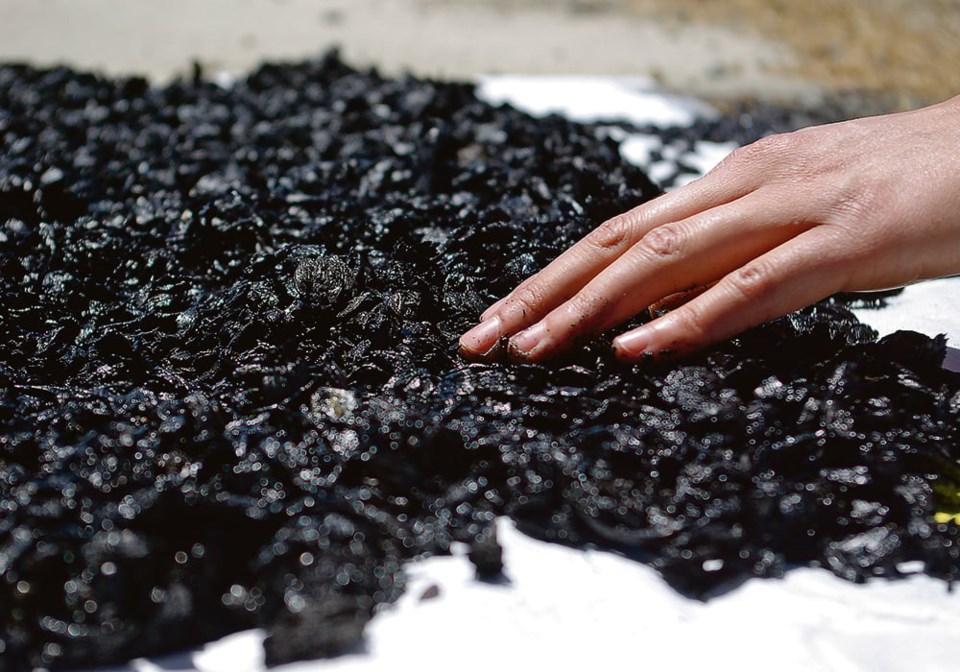WESTERN PRODUCER — Researchers find that adding charcoal-like carbon and ash to composting manure can reduce odours as well as methane
Researchers have found that adding a small amount of biochar during the composting process for manure from dairy cattle can cut methane emissions by 84 percent.
Minimizing the greenhouse gases behind climate change is sometimes seen as a problem that requires expensive high-tech solutions, said Gerardo Diaz, professor of mechanical engineering at the University of California, Merced.
“And if this can (instead) be done with materials that are already available, are cheap to make and in a certain way, you’re using waste — that is, the biomass — then, why not? It’s kind of like a no brainer.”
Biochar is the charcoal-like carbon and ash left over when biomasses such as crop residues are heated using pyrolysis under conditions of low oxygen. A study by researchers at the university found that adding as little as six percent biochar to dairy manure resulted in an 84 percent reduction of methane during composting.
However, biochar could also potentially reduce odours as well as methane emissions from manure in other livestock sectors such as beef cattle feedlots, said Rebecca Ryals, associate professor of agroecology in the university’s department of life and environmental sciences.
“I think biochar is an exciting thing to be studying right now because I think that there’s a lot of potential applications to it.”
Ryals said the findings about biochar and dairy manure underline the importance of taking a broader approach to organic waste from different sectors of agriculture. It could include using it to generate renewable energy such as electricity, she said.
It is vital to rethink such waste as a resource that potentially connects farmers in different sectors to their mutual benefit as part of a regional loop, said Ryals.
“We do put that into the context of these larger life cycle climate costs and benefits, and that’s in our paper as well.”
Methane is about 25 to 28 times more powerful as a greenhouse gas than carbon dioxide on a 100-year timescale, she said.
“If we consider it on a 20-year timespan instead of a 100-year timespan, it’s actually 80 times more powerful at trapping heat than carbon dioxide.”
Dairy farms are a significant source of global methane emissions, said Ryals. Due to the large size of the sector in California, she described it as the top source of methane from human activity in the state.
Producers in California often flush the waste from dairy barns, with the resulting liquid going into large, uncovered ponds. They are 小蓝视频 encouraged to take action to reduce methane by installing anaerobic digesters by 2030.
“And so, with the liquids, you can use those in a digester,” said Ryals. “Methane is produced from that process, but you can capture it through that digester and convert it to electricity.”
However, solids from dairy manure have also been a challenge because farmers tend to stockpile them. One way to further reduce methane emissions is to instead compost such solids, which currently isn’t a common practice in California.
Methane is produced by microbes that favour anaerobic conditions, where oxygen is absent. Although composting is an aerobic process, methane can still be created if the compost pile is too wet, or it contains what Ryals described as anaerobic microsites.
Because biochar is quite porous with a large surface area, it “kind of fluffs up that compost pile and allows for that more ideal aeration… so there’s oxygen more freely flowing throughout that pile and less chances for those anaerobic microsites to occur.”
It creates conditions that instead favour microbes that metabolize methane, said Ryals.
“It basically changes the ecosystem of the compost pile to make it more aerobic and we see huge reductions in those methane emissions.”
Unpublished research that was recently conducted at the university tested various types of biochar involving different feedstocks and application rates, she said.
“It’s still dairy manure, but here we tested almond shells, almond clippings, walnut shells, walnut clippings, and then all of those applied either at that six percent rate or at 20 percent.”
Compared to composting without biochar, all these variations resulted in a net reduced carbon dioxide equivalent, which is a measure of greenhouse gas impact, that included nitrous oxide and carbon dioxide as well as methane, said Ryals. However, boosting the biochar to 20 percent resulted in the creation of large aggregates within the compost, creating more methane, she said.
The fact that the best results were obtained at six percent biochar is good news for dairy farmers, said Ryals.
“It’s actually a relatively small proportion that you need to add to get that savings.”
Diaz said creating a new market for biochar could also benefit small producers or disadvantaged communities with low incomes, such as those within California’s Central Valley. The region contains much of the state’s agriculture industry, which generates a significant amount of organic waste.
“We wanted to have some sort of way in which they could convert their biomass into some of these products like the biochar, so part of the project also involves working to look at different technologies that could potentially be mobile.”
Diaz cautioned they must not result in the creation of greenhouse gases. He pointed to the San Joaquin Valley Air Pollution Control District, which plans to implement a ban on open agricultural burning by 2025.
“That is going to make it very, very hard for people to be able to process the biomass that gets produced here without 小蓝视频 able to get rid of it, so again, all these technologies that are available, whether they are stationary or they are mobile, do help quite a bit.”
The study suggested composted dairy manure containing biochar could also result in better fertilizer that could be sold to other farmers to boost yields. It could also increase the sequestration of carbon in soil, helping to further minimize climate change, said Diaz.




